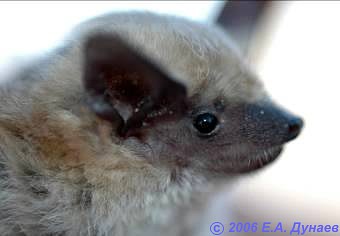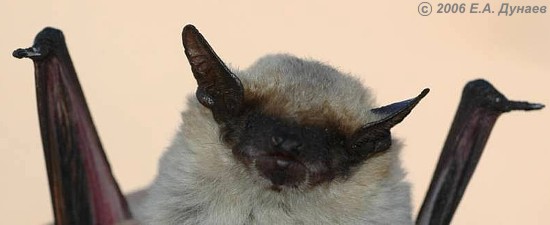Botta's serotine
Bottas bat ( Eptesicus bottae ) is within the bats to the family of Myotis bats ( Vespertilionidae ). It is distributed in the Arab world from Turkey to the Middle East.
Features
Botta's bat is a medium-sized bat with a head-body length of 48-64 mm with a weight 12-23 grams. The tail reaches a length of 35 to 44.5 mm, and the span is 27 to 33 inches with a forearm length of 40 to 50 mm.
The fur of the bat is black and has brown on top, silver-white tips, giving it a " frosted " or " moldy " appearance. The underside is white with gray almost pure white throat and thereby sharply demarcated from the top. The muzzle, ears and wing membranes are dark brown. The juveniles are lighter than the older animals and act on the back silvery- white, while the belly is yellowish white.
The ears are short, broad and rounded. They reach a length of 12 to 18.8mm and have at the rear edge of the ear 4 transverse folds. The tragus is short and widens upwards, which it reaches its greatest width in the second third of the height. The wings are narrow and the Armflughaut attaches to the carpus. The tail wing membrane has a clear Epiblema with highly visible web and the calcar ( spur ) is longer than half of the tail wing membrane length. The tail is 3.5 to 5 mm free with the last two tail vertebrae.
Distribution and habitat
The distribution area of Botta's bat extends from southern Turkey through Syria, Jordan and Israel along the west and south coasts of the Arabian peninsula to Oman and the United Arab Emirates. In addition, it extends from the Black Sea (Georgia) and Iraq over Iran and along the coast of the Caspian Sea through Turkmenistan and Uzbekistan into southern Kazakhstan, northern Afghanistan, Tajikistan and Kyrgyzstan. In Europe, the species was observed on the Greek island of Rhodes and it is thought that they would have to be found also on other Greek islands.
As habitat prefer bats semi-arid lowland areas with steppe- character, however, they also occur in the mountains up to 1850 meters altitude in Kurdistan and 2100 meters altitude in Oman. They live in natural caves and crevices as well as ruins and buildings.
Way of life
The bat hunts at night especially relatively high in open terrain, but also on low vegetation or in the light of street lamps. The flight of the animals is fast with rapid turns.
In summer, the type column inhabited buildings and rocks. The females give birth to one to two pups, the young are able to fly from July. Over the winter quarters are no more accurate data.
System
Bottas bat of the genus serotine bats ( Eptesicus ) is assigned, consisting of 32 species worldwide. In Europe, live from this genus the Serotine (E. serotinus ) and the Northern bat (E. nils soni ).
Threat and protection
The species is regarded globally as " not threatened " by the International Union for Conservation of Nature and Natural Resources ( IUCN) due to the large distribution area and population size ( Least concern ). A decline in population and greater threat of the species are not known.










